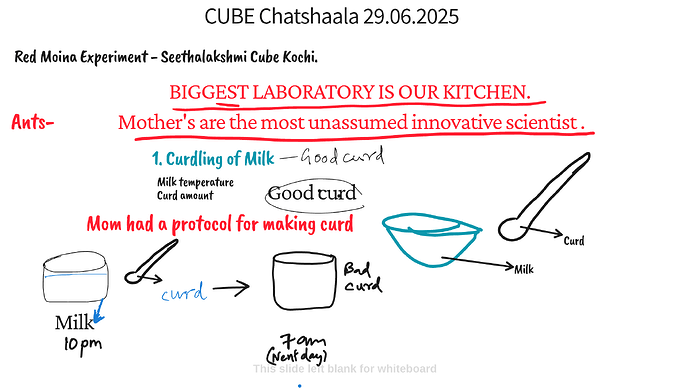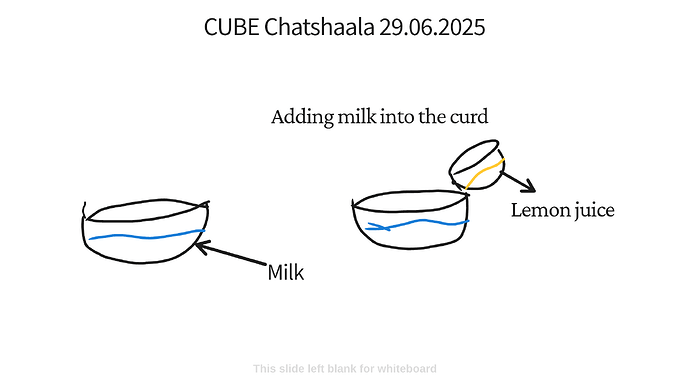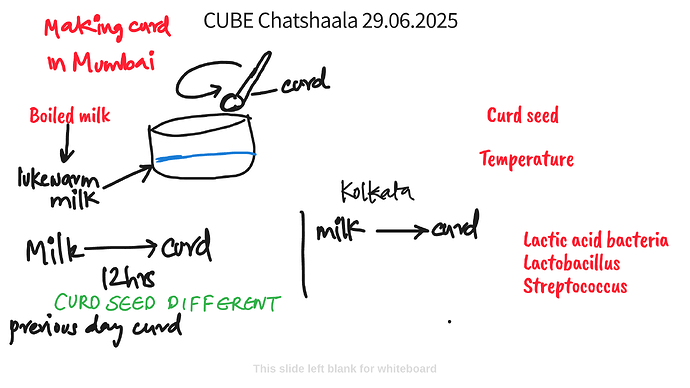Topic : Red Moina & Everyday Science – Seethalakshmi, CUBE Kochi
The CUBE ChatShaala on 29th June 2025 focused on the Red Moina experiment and creatively bridged this with traditional knowledge practices, particularly the making of curd in Indian households. Seethalakshmi from CUBE Kochi initiated the discussion with a powerful statement: “The biggest laboratory is our kitchen” , emphasizing the unnoticed innovations practiced daily by mothers, especially in food preparation.
- Kitchen Science as a Model of Protocol-Based Experimentation
The curdling of milk was taken as a model system to demonstrate how a scientific protocol can be followed in domestic settings:
Milk at 10 PM was used with a spoon of curd as a starter culture.
By 7 AM the next morning, either good curd or bad curd was formed—depending on key variables like:
-
Milk temperature
-
Amount of curd added
This led to the realization that “Mom had a protocol for making curd”, involving precise control of environmental factors—just like in a lab.
- Variables in the Curd Formation Process
The participants investigated further with modifications:
In one setup, milk was added to curd , and in another, lemon juice was added to initiate curdling—highlighting chemical and microbial pathways for acidification and milk protein denaturation.
- Location-Based Variability in Curd Preparation
Comparative analysis between two regions—Mumbai and Kolkata—revealed interesting variations:
In Mumbai :
Boiled milk cooled to lukewarm temperature was seeded with curd.
The curd formed in ~12 hours.
A key observation : the curd seed was different, taken from the previous day’s curd, which may have had a distinct microbial composition.
In Kolkata :
Similar steps were followed but with subtle differences possibly due to ambient temperature and seed culture variability.
This led to the recognition of the important microbial players in the curdling process:
![]() Lactic acid bacteria
Lactic acid bacteria
![]() Lactobacillus
Lactobacillus
![]() Streptococcus
Streptococcus
![]() Conclusion
Conclusion
The ChatShaala session successfully demonstrated how everyday practices can be reverse-engineered into scientific protocols. Curd formation was presented not only as a culinary art but as a reproducible biological experiment involving microbial fermentation— bridging microbiology, food science , and local knowledge systems .
![]() Queries to Explore Based on Today’s Whiteboard :
Queries to Explore Based on Today’s Whiteboard :
-
What are the optimal conditions (temperature, time, curd amount) for consistent curd formation in different climatic regions?
-
How does the microbial composition of curd seeds vary between households and over time?
-
Can we culture and isolate Lactobacillus and Streptococcus from household curd using simple kitchen-lab tools?
-
Does lemon juice produce the same kind of curd as curd-seeding? What are the differences in texture and bacterial content?
-
What lessons from curd-making can we apply to the Red Moina experiment, especially in understanding microbial environments?
Let us continue questioning and experimenting—right from the kitchen to the lab.
@Arunan @shivani @Theertha @2020ugchsncnseethala @Susanta_Tanti @akanksha @Nidhi @ajita @KiranKalakotiR @Himanshu and others.
Reference ![]()
- Curdling - Wikipedia
- A Milk-Curdling Activity | Scientific American
- What are curds and whey? - Let's Talk Science
Whiteboard Summary + Reflections from the Scicom Group (DAE)
The ChatShaala on 29.06.2025 brought forward key insights into how everyday environments such as our homes—specifically the kitchen—serve as unconventional yet powerful spaces for scientific exploration. Participants enthusiastically engaged in a discussion rooted in the idea that mothers are among the most unacknowledged, innovative scientists, using their kitchens as dynamic laboratories.
This sentiment was echoed and appreciated by members of the Scicom group, primarily comprising scientists from the Department of Atomic Energy (DAE) , who responded with affirmation and encouragement. Their engagement underlined a bridging of formal and informal scientific communities and further validated the core philosophy of the CUBE model— science for, by, and with the people .
The interactive whiteboard session showcased ideas for simple, replicable experiments rooted in domestic observations. These included examples such as fermentation, seed germination, and traditional food preservation methods—demonstrating scientific concepts like microbial action , osmosis , and enzyme activity in real-world , accessible settings .
![]() Follow-up Queries Based on the Whiteboard:
Follow-up Queries Based on the Whiteboard:
-
Can we collect and document experiments performed by mothers or other household members that illustrate key biology concepts?
-
How can these informal innovations be translated into formal school-level biology projects or curriculum models?
-
Can we use our kitchens to replicate classic biological experiments like Pasteur’s broth experiment or Mendel’s genetics models using kitchen-grown mustard?
-
What are some examples where food spoilage turned into an opportunity for microbial studies or understanding decay cycles?
-
Can fermentation practices across Indian households be mapped geographically to study microbial biodiversity?


